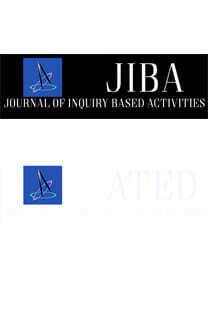RUS KÖYLÜLERİN GELİŞTİRDİĞİ ÇARPMA YÖNTEMİ NASIL VE NEDEN ÇALIŞIYOR?
Bu makalede, çarpma konusunda öğrencilerin hem işlemsel bilgilerini hem de kavramsal bilgilerini geliştirmek amacıyla tasarlanan ve uygulanan bir etkinlik tanıtılmıştır. Öğrenciler, fiziksel ve zihinsel olarak aktif bir şekilde, Rus köylüleri tarafından geliştirilen bir çarpma yöntemini incelemişler, yöntemin neden ve nasıl çalıştığını açıklamışlar ve yöntemi genişletmişlerdir. Etkinlik güney batı illerimizden birisinde bulunan bir Bilim Sanat Merkezi’nde uygulanmıştır. Uygulama, 11 ve 15 kişiden oluşan iki ayrı sınıfta yapılmıştır. Uygulama süresi 1 saattir. Etkinlikte öğrenciler, birim küpleri kullanarak ve çarpmanın alan anlamı üzerine odaklanarak öğrendikleri yeni çarpma algoritmansını anlamlandırmışlardır. Dersin etkililiği, öğretmen tarafından tutulan gözlem notları ve öğrencilerin doldurduğu çalışma kağıtları kullanılarak değerlendirilmiştir. Dersin genel olarak öğrencilerin kavramsal ve işlemsel bilgisini geliştirdiği tespit edilmiştir.
HOW AND WHY DOES THE MULTIPLICATION METHOD DEVELOPED BY THE RUSSIAN PEASANTS WORK?
In this article, an activity designed and implemented to improve both procedural knowledge and conceptual knowledge of multiplication is introduced. The students were physically and mentally active while exploring a multiplication method developed by the Russian peasants. They not only explained why and how the method works, but also extended the method. The activity was implemented at a Science and Art Center located in one of southwestern cities in Turkey. The activty was implemented in two classes having 11 and 15 students respectively. The lesson took an hour. The students used unit cubes and focused on the area meaning of multiplication to comprehend the new multiplication algorithm that they have learnt. The effectiveness of the lesson was assessed using observation notes of the teacher and worksheets completed by the students. The assessment results indicate that the lesson supported the conceptual and procedural understanding of the students. Keywords: Russian peasant multiplication method, conceptual knowledge, procedural knowledge.
___
- Atasoy, E., & Atasoy, Ş. (2006). Farklı yazma etkinliklerinin 6. Sınıf öğrencilerinin düşünceleri ve davranışları üzerindeki etkilerinin belirlenmesi [Determination of the effects of different writing activities on students’ thinking and behaviors of Grade 6 students]. Hasan Ali Yücel Eğitim Fakültesi Dergisi, 3(1), 1-18.
- Birgin, O., & Gürbüz, R. (2009). İlköğretim II. kademe öğrencilerinin rasyonel sayılar konusundaki işlemsel ve kavramsal bilgi düzeylerinin incelenmesi [Examining the primary school stage II students’ level of procedural and conceptual knowledge of rational numbers]. Uludağ Üniversitesi Eğitim Fakültesi Dergisi, 22(2), 529-550
- Burns, M. (2004). Writing in math. Educational Leadership, 62(2), 30-33.
- Kilpatrick, J., Swafford, J., & Findell, B. (Eds.). (2001). Adding it up: Helping children learn mathematics. Washington, D.C.: National Academy Press.
- Lee, J. E. (2014). Deciphering with the area model multiplication algorithms. Mathematics Teaching in the Middle School, 19(9), 556-563.
- Lin, C. Y. (2007). Teaching multiplication algorithms from other cultures. Mathematics Teaching in the Middle School, 13(5), 298-304.
- Ministry of National Education. (2005). İlköğretim matematik dersi 6-8. Sınıflar öğretim program ve kılavuzu [Foundational education 6-8 grades mathematics curriculum and guide]. Ankara: Talim ve Terbiye Kurulu Başkanlığı.
- Ministry of National Education. (2017). Matematik dersi öğretim programı (İlkokul ve ortaokul 1, 2, 3, 4, 5, 6, 7 ve 8. sınıflar) [Mathematics curriculum Elementary and middle school 1, 2, 3, 4, 5, 6, 7, and 8th grades)]. Retrieved from http://mufredat.meb.gov.tr/ProgramDetay.aspx?PID=329
- National Council of Teachers of Mathematics. (2000). Principles and standards for school mathematics. Reston, VA: Author
- National Council of Teachers of Mathematics. (2014). Principles to actions: Ensuring mathematics success for all. Reston, VA: Author.
- National Governors Association Center for Best Practices, Council of Chief State School Officers (2010). Common core state standards for mathematics. Retrieved from http://www.corestandards.org/assets/CCSSI_Math%20Standards.pdf
- Olkun, S., & Uçar, Z. T. (2009). İlköğretimde etkinlik temelli matematik öğretimi [Activity-based mathematics teaching in foundational education]. Ankara: Maya Akademi Eğitim ve Danışmanlık
- Seo, B. (2015). Mathematical writing: What is it and how do we teach it? Journal of Humanistic Mathematics, 5(2), 133-145. doi: 10.5642/jhummath.201502.12
- Van de Walle, J. A., Karp, K. S., & Bay-Williams, J. W. (2013). İlkokul ve ortaokul matematiği: Gelişimsel yaklaşımla öğretim [Elementary and middle school mathematics: Teaching developmentally] (7. baskıdan çeviri).(S. Durmuş, Çev. [Trans.]). Ankara: Nobel Yayınları
- Yılmaz, N. (2015). Cebir öğretiminde yazma etkinliklerini kullanmanın ortaokul 7. sınıf öğrencilerinin başarılarına etkisi [The impact of using writing activities in teaching algebra on secondary school seventh grade students’ achievements]. Abant İzzet Baysal Üniversitesi Eğitim Fakültesi Dergisi, 15(1), 357-376.
- ISSN: 2146-5711
- Yayın Aralığı: Yılda 2 Sayı
- Başlangıç: 2011
- Yayıncı: Evrim Erbilgin
Sayıdaki Diğer Makaleler
BİR MATEMATİKSEL MODELLEME ETKİNLİĞİ: MURAT’IN CEP TELEFONU
Burçak BOZ-YAMAN, Melike UYARLI
LEARNING MATHEMATICS WITH CREATIVE DRAMA
RUS KÖYLÜLERİN GELİŞTİRDİĞİ ÇARPMA YÖNTEMİ NASIL VE NEDEN ÇALIŞIYOR?
MATHEMATICAL MODELING ACTIVITY: MURAT’S MOBILE PHONE
BURÇAK BOZ YAMAN, Melike UYARLI
YARATICI DRAMA İLE MATEMATİK ÖĞRENİYORUM
PREPARING DATA REPRESENTATION ACTIVITIES FOR YOUNG LEARNERS
KÜÇÜK ÇOCUKLAR İÇİN VERİ GÖSTERİMİNE YÖNELİK AKTİVİTELER HAZIRLAMA
HOW AND WHY DOES THE MULTIPLICATION METHOD DEVELOPED BY THE RUSSIAN PEASANTS WORK?
